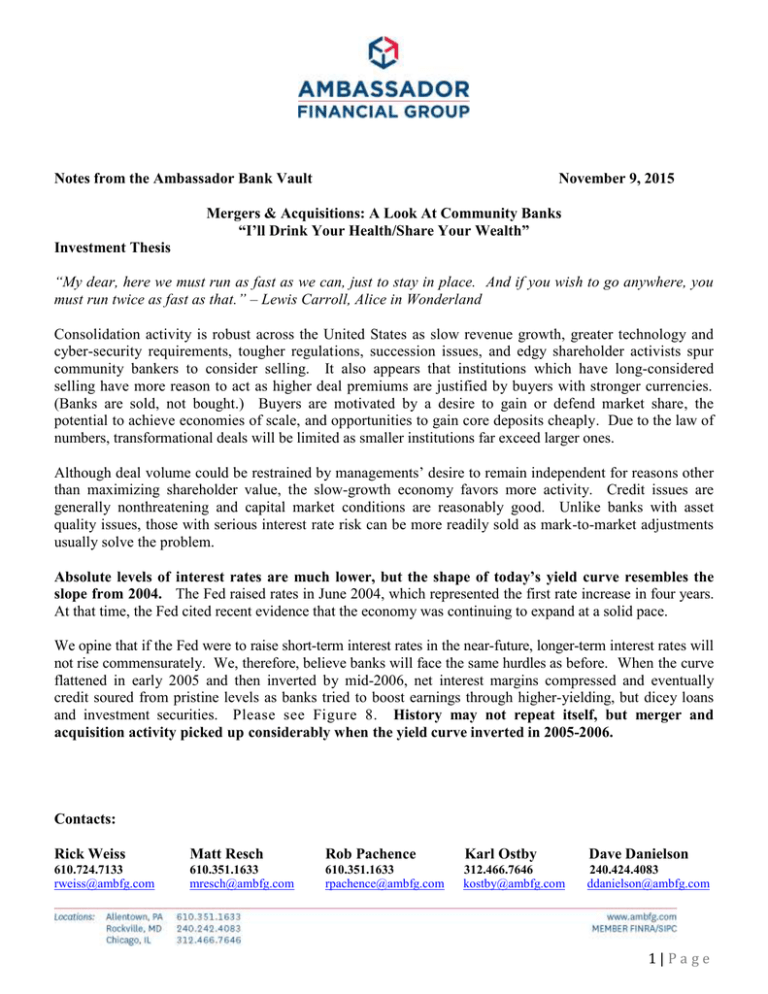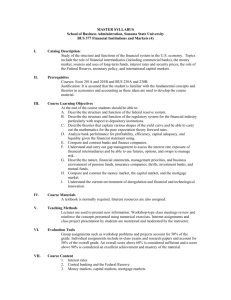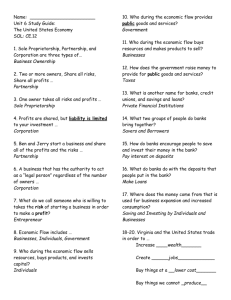A_Look_At_MA_Community_Banks_-Nov_2015
advertisement

Notes from the Ambassador Bank Vault November 9, 2015 Mergers & Acquisitions: A Look At Community Banks “I’ll Drink Your Health/Share Your Wealth” Investment Thesis “My dear, here we must run as fast as we can, just to stay in place. And if you wish to go anywhere, you must run twice as fast as that.” – Lewis Carroll, Alice in Wonderland Consolidation activity is robust across the United States as slow revenue growth, greater technology and cyber-security requirements, tougher regulations, succession issues, and edgy shareholder activists spur community bankers to consider selling. It also appears that institutions which have long-considered selling have more reason to act as higher deal premiums are justified by buyers with stronger currencies. (Banks are sold, not bought.) Buyers are motivated by a desire to gain or defend market share, the potential to achieve economies of scale, and opportunities to gain core deposits cheaply. Due to the law of numbers, transformational deals will be limited as smaller institutions far exceed larger ones. Although deal volume could be restrained by managements’ desire to remain independent for reasons other than maximizing shareholder value, the slow-growth economy favors more activity. Credit issues are generally nonthreatening and capital market conditions are reasonably good. Unlike banks with asset quality issues, those with serious interest rate risk can be more readily sold as mark-to-market adjustments usually solve the problem. Absolute levels of interest rates are much lower, but the shape of today’s yield curve resembles the slope from 2004. The Fed raised rates in June 2004, which represented the first rate increase in four years. At that time, the Fed cited recent evidence that the economy was continuing to expand at a solid pace. We opine that if the Fed were to raise short-term interest rates in the near-future, longer-term interest rates will not rise commensurately. We, therefore, believe banks will face the same hurdles as before. When the curve flattened in early 2005 and then inverted by mid-2006, net interest margins compressed and eventually credit soured from pristine levels as banks tried to boost earnings through higher-yielding, but dicey loans and investment securities. Please see Figure 8. History may not repeat itself, but merger and acquisition activity picked up considerably when the yield curve inverted in 2005-2006. Contacts: Rick Weiss Matt Resch Rob Pachence Karl Ostby Dave Danielson 610.724.7133 rweiss@ambfg.com 610.351.1633 mresch@ambfg.com 610.351.1633 rpachence@ambfg.com 312.466.7646 kostby@ambfg.com 240.424.4083 ddanielson@ambfg.com 1|Page Highlights According to SNL Financial, there were 236 bank and thrift deal announcements from January 1, 2015, through October 31, 2015, compared with approximately the same number of deals for the same 2014 period. High profile deals announced in 2015 include: Key Bancorp (NYSE: KEY)/First Niagara (NASDAQ: FNFG), Royal Bank of Canada (RY: TSX)/City National (NYSE: CYN) (completed November 2), and New York Community (NYSE: NYCB)/Astoria Financial (NYSE: AF). Also, after a long delay, M&T Bank Corp. (NYSE: MTB) completed its acquisition of Hudson City Bancorp. The United States banking market has grown more concentrated due to consolidation. The top ten banks have a combined United States deposit market share of 54% and Bank of America (NYSE: BAC), Citigroup, Inc. (NYSE: C), JP Morgan (NYSE: JPM), and Wells Fargo (NYSE: WFC) have a combined nationwide deposit share of 35%, respectively. As of October 31, 2015, there were approximately 1,000 publicly-traded banks and thrifts with assets greater than $100 million, 52 banks and thrifts with total assets between $10 and $50 billion, and 26 banks and thrifts with assets between $7.5 and $10 billion. Smaller institutions can combine to achieve economies of scale, including the latitude to raise loans-toone borrower limits. For instance, two Wisconsin-based companies - Nicolet Bancshares, Inc. (NASDAQ: NCBS) and Baylake Corp. (NASDAQ: BYLK) – recently announced a merger-of-equals (MOE). There should be more of this type of transaction as MOEs are often attractive strategically and financially. That said, they rarely occur due mainly to social considerations. Improved asset quality through the September 2015 quarter should increase confidence among potential buyers that they are not “buying problems”. Companies with superior asset quality or at least those that exhibit signs that the credit has improved are more desirable merger candidates. Effective cyber-security is a major concern and entails much more than a one-time technology upgrade. Management and staff must exercise proper corporate governance and prove to regulators that complex operational risk issues are under control. Board of Directors should discuss security issues on a regular basis. Banks of all sizes need to upgrade risk management systems, which will weigh down efficiency ratios and earnings in the short-run. Companies that invest in technology and enhanced management systems should seek strategic partnerships to realize economies of scale. One of the bigger cost elements related to compliance is staffing, and smaller banks, in particular, are more apt to sell as they often lack the critical mass of interest-earning assets and/or other revenue drivers to offset fixed costs. Despite more widespread shareholder activism, consolidation activity could be restrained by managements’ desire to remain independent for social and other reasons, rather than strictly adhering to the discipline of maximizing shareholder value. 2|Page Table of Contents Investment Thesis ........................................................................................................................................ 1 Highlights .................................................................................................................................................... 2 Valuation Summary ..................................................................................................................................... 3 M&A Thesis ................................................................................................................................................ 6 Valuation Summary Based on anecdotal evidence, it appears that there is a disparity regarding pricing expectations between buyers and sellers. Investors often assess deals based on tangible book value; and not necessarily earnings. It appears that potential buyers have balked at rich book value valuations and longer earn-back periods, even if deals are accretive to earnings. As of October 31, 2015, the median price-to-trailing 12 month earnings and price-to-tangible book multiples for banks and thrifts with assets between $500 million and $15 billion nationally were 14.9x and 126%, respectively. Many of the stock prices of those banks and thrifts are based on tangible book value, rather than earnings. On a national scale, the stock price performance of acquirers was generally strong over the past 24 months or so. From the time that deals were announced in 2013, 2014, and 2015, stock prices of the buyers have increased by medians of 11.4% and 13.2% for bank and thrift acquisitions, respectively, as of Oct ober, 31, 2015 . We generally attribute such performance to t h e o v e r a l l m a r k e t a n d deals that were reasonably valued and made sense strategically. We opine that low premium deals afford higher price potential on a combined basis because management does not need to extract cost savings that hurt, rather than help, long-term profitability. The stock prices, however, of both Key Bancorp and New York Community suffered after announcing the acquisitions of First Niagara and Astoria, respectively. The First Niagara and Astoria deals represented the largest and third largest acquisitions announced in 2015, respectively. Although both deals were viewed as good strategic fits, investors appeared concerned with the tangible book value dilution, relatively long earn-back period, and suspension of the buyback regarding the Key/First Niagara deal. It appears that the market was concerned with New York Community’s dividend cut and the implications of the company being deemed a systemically important institution (“SIFI”). Key’s stock price dropped 7.2% the day after the deal was announced and shares of New York Community fell 13.6% over the first two days following its deal announcement. 3|Page Figure 1 300 30 250 25 200 20 150 15 100 10 Price/LTM EPS Deal: Price/LTM EPS Price/TBV 2015 (Q3) 2014 2013 2012 2011 2010 2009 2008 2007 2006 2005 2004 0 2003 0 2002 50 2001 5 Price/ Tnagible book Value (%) 35 2000 Price to LTM EPS (x) Median Bank Trading Multiples Deal: Price/TBV Note: All publicly traded banks and thrifts. Source: SNL Financial Figure 2 300 30 250 25 200 20 150 15 100 10 Price/LTM EPS Deal: Price/LTM EPS Price/TBV 2015 (Q3) 2014 2013 2012 2011 2010 2009 2008 2007 2006 2005 2004 0 2003 0 2002 50 2001 5 Price to Tangible Book Value (%) 35 2000 Price to LTM EPS (x) Median Thrift (ex. MHCs) Trading Multiples Deal: Price/TBV Note: All publicly traded banks and thrifts. Source: SNL Financial 4|Page Figure 3 Number of Bank and Thrift Deals by Year* 350 299 Number of Deals 300 287 270 287 250 222 227 2012 2013 236 182 200 152 148 150 109 100 50 0 2005 2006 2007 2008 2009 2010 2011 2014 2015 (YTD*) *2015 deal count is inclusive of all deals (non-government assisted) from 1/1/2015 through 10/31/2015 Source: SNL Financial Figure 4 2015 Deals YTD by Region* 90 85 80 70 60 49 50 36 40 30 28 26 20 12 10 0 Mid Atlantic Midwest Northeast Southeast Southwest West *2015 deal count is inclusive of all deals (non-government assisted) from 1/1/2015 through 10/31/2015 Source: SNL Financial 5|Page M&A Thesis Our v i e w is that the U.S . banking industry will continue to consolidate to alleviate irrational pricing decisions, achieve economies of scale, and satisfy shareholders. Since the mid-1980s, there have been thousands of acquisitions/mergers as the number of banks decreased from approximately 15,000 to about 5,550 today. Until the Great Recession, however, start-up banks were often formed to fill a need in the market as well as provide jobs for displaced bankers. That has changed as only two de novo banks were organized since 2010 due to both economic and regulatory reasons. Please see Figure 5 regarding the decline in the number of banks and thrifts. For modeling purposes, we assume the projected decline in institutions assumes the same decay rate as that from 2008-2014. Figure 5 Projected Decline in Number of Institutions* 9,000 8,000 7,401 7,284 7,088 6,841 7,000 6,000 6,531 6,292 6,097 5,877 5,643 5,455 5,273 5,097 4,927 5,000 4,000 3,000 2,000 1,279 1,250 1,218 1,171 1,127 1,065 986 935 866 825 786 749 714 2012 2013 2014 2015 2016 2017 2018 1,000 2006 2007 2008 2009 2010 2011 Banks Thrifts *2015-2018 based on average annual rate of decline from 2008 -2014. 3.3% for banks and 4.7% for thrifts Note: Industry wide data Source: FDIC Merger and acquisition activity will likely be ubiquitous for the foreseeable future as both potential buyers and sellers have the means and motivation to enter into strategic partnerships. I n addition to whole bank acquisitions, we expect banks will be interested in purchasing non-bank financial companies along with selected branch purchases. We also believe d e a l s will be concentrated in more active markets across the United States where buyers have a better chance of accelerating earnings growth. Franchises located in slow growing and rural markets, however, can also be desirable because of their core deposits. As shown in Figure 6, there were only eight deals announced in 2015 (to date) which involved a seller with assets greater than $2 billion. Given the dwindling number of mid-sized banks across the nation, it is logical to assume that most industry consolidation will occur chiefly among the smaller banks. 6|Page Figure 6 – Higher Profile 2015 Deals Seller State Announcement Date City National Corp Square 1 Financial Metro Bancorp National Penn Bancshares CA NC PA PA 1/22/2015 3/2/2015 8/4/2015 8/17/2015 32,015,600 3,094,866 3,001,357 9,604,314 Community & Southern NewBridge Bancorp Astoria Financial First Niagara Financial GA NC NY NY 10/19/2015 10/13/2015 10/29/2015 10/30/2015 3,790,170 2,778,685 15,099,204 39,413,181 Buyer Seller Royal Bank of Canada PacWest Bancorp F.N.B. Corporation BB&T Corporation Bank of the Ozarks, Inc. Yadkin Financial Corporation New York Community Bancorp KeyCorp Seller Deal Value Assets at Announcement ($000s) ($mil) Price/ Tang Book (%) Price/ LTM Earn (x) Core Deposit Premium (%) 5,400 849 474 1,830 272 280 178 219 22.9 23.3 22.7 17.7 12.3 19.8 9.4 15.4 800 456 2,000 4,100 199 197 146 169 47.4 22.6 23.0 19.3 18.3 13.1 NA 6.7 Source: SNL Financial, Inc. Community banks that approach assets of $10 billion appear more likely to engage in merger and acquisitions - either as a buyer or seller. More draconian regulatory rules kick in when institutions reach this asset level which include, but are not limited to: mandatory stress testing, direct regulation by the Consumer Finance Protection Board (CFPB), and caps on interchange fees pursuant to the Durbin Amendment. Based on anecdotal evidence, banks prefer to hurdle over the $10 billion asset level via a larger deal, rather than crawl over via organic growth or a smaller acquisition. The announced sale by National Penn Bancorp (NASDAQ: NPBC) to BB&T Corp. (NYSE: BBT) is an example of a bank ($9.6 billion in assets) unwilling to cope with the cost and hassle of exceeding $10 billion. On the other hand, The Bank of the Ozarks, Inc. (NASDAQ: OZRK) announced the purchase of Community & Southern Holdings, Inc. ($4.0 billion), which represents an example of a bank going over the threshold in a meaningful manner. The challenge will be for those banks to find a willing seller among banks with assets between $3 and $6 billion. Mergers-of-equals (MOEs) among banks with assets between $5 and $10 billion often make sense in theory, but rarely occur due to social considerations. 7|Page Figure 7 - Banks Approaching $10 billion in Assets Tang Equity/ Assets (%) ROAA (%) 9,935,046 9,844,161 9,798,654 9,587,459 9,413,996 9,329,216 9,264,554 8,934,908 8,858,588 8,764,299 8.5 14.4 8.3 9.1 9.4 12.7 7.6 10.3 NA 10.8 0.80 0.70 1.12 1.13 0.91 2.01 0.96 0.79 0.92 1.42 6.6 5.3 7.5 8.9 9.4 15.0 8.2 5.7 6.7 11.1 17.1 22.4 14.9 16.1 17.7 25.9 15.6 20.1 15.2 18.0 170 126 209 199 167 381 189 153 180 221 WA MT TN AR SC WV NY NY MS OH 8,755,984 8,604,530 8,544,799 8,515,553 8,499,876 8,452,430 8,161,562 7,997,166 7,918,732 7,880,533 10.1 8.6 8.7 9.2 8.1 7.8 7.6 8.7 7.4 7.9 1.09 1.06 1.24 1.63 0.95 1.12 0.97 1.23 1.02 0.96 7.4 9.9 9.2 12.3 7.8 9.0 8.8 9.7 8.6 8.9 21.0 15.1 21.8 22.4 19.7 15.5 16.4 17.9 18.7 16.1 228 178 304 389 284 202 204 253 253 198 BHLB CVBF CUBI UBSH BBCN SFNC PRK CBF BANC MA CA PA VA CA AR OH FL CA 7,804,488 7,626,462 7,599,471 7,594,313 7,583,002 7,559,694 7,300,340 7,261,196 7,256,810 7.3 11.2 7.0 9.3 11.0 NA 8.9 NA 8.1 0.55 1.45 0.78 0.72 1.30 0.80 1.22 0.77 0.69 4.9 12.5 10.4 5.3 10.4 8.1 12.3 4.7 7.3 17.3 19.4 14.9 17.6 14.4 20.6 16.6 28.3 11.3 162 220 159 167 163 243 216 165 125 OFG Bancorp OFG Boston Private Financial Holdings, Inc.BPFH Independent Bank Corp. INDB FCB Financial Holdings, Inc. FCB LegacyTexas Financial Group, Inc. LTXB Heartland Financial USA, Inc. HTLF Talmer Bancorp, Inc. TLMR First Financial Bankshares, Inc. FFIN BancFirst Corporation BANF First Commonwealth Financial Corporation FCF PR MA MA FL TX IA MI TX OK PA 7,203,822 7,180,528 7,135,489 6,888,689 6,878,843 6,805,884 6,504,035 6,467,645 6,406,096 6,384,749 11.4 NA 7.9 11.3 9.1 NA 10.8 10.3 9.3 9.0 1.10 1.11 0.95 0.41 0.85 0.72 1.61 1.65 1.00 0.71 9.3 11.0 9.7 2.9 5.6 8.9 12.5 14.0 10.9 6.2 NM 16.4 19.3 42.8 21.9 13.1 21.6 22.0 14.8 17.3 63 196 225 190 224 177 159 337 162 146 BofI Holding, Inc. BOFI S&T Bancorp, Inc. STBA First Merchants Corporation FRME Opus Bank OPB TowneBank TOWN Farmers & Merchants Bank of Long FMBL Beach Eagle Bancorp, Inc. EGBN United Financial Bancorp, Inc. UBNK Brookline Bancorp, Inc. BRKL Tompkins Financial Corporation TMP CA PA IN CA VA CA MD CT MA NY 6,259,648 6,215,338 6,189,797 6,183,155 6,173,891 5,978,890 5,888,958 5,843,022 5,839,529 5,594,718 9.2 NA 9.2 9.8 10.7 14.2 NA 8.7 9.1 7.5 1.61 1.22 1.08 1.00 0.92 1.14 1.31 0.16 0.82 1.03 18.2 9.7 8.9 5.8 7.4 7.9 11.9 1.3 7.1 10.8 13.9 16.3 14.9 22.2 18.2 12.1 20.3 15.6 16.7 14.3 219 235 181 210 175 93 272 132 156 196 FFIC NY BANR WA ABCB GA BNCN NC SRCE IN WTBFB WA WSFS DE CPF HI WABC CA 5,502,075 5,312,310 5,216,300 5,201,118 5,105,584 5,069,283 5,067,942 5,021,833 5,001,395 8.3 12.2 7.8 7.4 11.0 8.9 NA 9.9 8.2 0.91 1.17 1.04 0.83 1.21 0.92 1.17 0.85 1.22 9.8 9.6 12.2 9.1 9.6 9.2 12.2 6.8 11.6 13.4 19.9 25.6 18.7 14.5 11.3 17.4 15.6 19.1 133 160 256 228 149 107 200 141 282 9.1 1.01 9.0 17.3 193 Name Ticker State First Midwest Bancorp, Inc. Capitol Federal Financial, Inc. Great Western Bancorp, Inc. National Penn Bancshares, Inc. United Community Banks, Inc. Bank of the Ozarks, Inc. Chemical Financial Corporation Northwest Bancshares, Inc. Provident Financial Services, Inc. Glacier Bancorp, Inc. FMBI CFFN GWB NPBC UCBI OZRK CHFC NWBI PFS GBCI IL KS SD PA GA AR MI PA NJ MT Columbia Banking System, Inc. First Interstate BancSystem, Inc. Pinnacle Financial Partners, Inc. Home BancShares, Inc. South State Corporation WesBanco, Inc. NBT Bancorp Inc. Community Bank System, Inc. Renasant Corporation First Financial Bancorp. COLB FIBK PNFP HOMB SSB WSBC NBTB CBU RNST FFBC Berkshire Hills Bancorp, Inc. CVB Financial Corp. Customers Bancorp, Inc. Union Bankshares Corporation BBCN Bancorp, Inc. Simmons First National Corporation Park National Corporation Capital Bank Financial Corp. Banc of California, Inc. Flushing Financial Corporation Banner Corporation Ameris Bancorp BNC Bancorp 1st Source Corporation W.T.B. Financial Corporation WSFS Financial Corporation Central Pacific Financial Corp. Westamerica Bancorporation Median Total Assets ($000s) Price/ ROAE LTM EPS (%) (x) Price/ Tang Book (%) * Return on average assets (ROAA) and return on average equity based on last 12 months reported earnings. Source: SNL Financial, Inc. 8|Page Earnings challenges are likely to continue for most financial institutions. Net interest margins remain under pressure as newly-originated loans generally have yields lower than those of legacy loans and funding costs cannot be significantly reduced at this point. We also opine that well-run banks are fairly efficient and will be unable to increase profits substantially through cost-cutting measures. Interest rate risk, rather than asset quality concerns, continues to be the primary concern among banking regulators. As shown in Figure 8 below, the slope of today’s yield curve resembles that from 2004, even though absolute levels of interest rates are much lower. Banks will face the same problems as in the previous decade if shortterm rates rise quicker than longer-term rates. When the curve flattened in 2005 and then inverted by mid2006, net interest margins compressed and eventually credit soured from pristine levels as banks tried to boost earnings through higher-yielding, but dicey loans and investment securities. History may not repeat itself but merger and acquisition activity picked up considerably when the yield curve inverted in 2005-2006 (Figure 3). Figure 8 Historical Treasury Yield Curve 6.0 5.0 Yield (%) 4.0 3.0 2.0 1.0 0.0 1 Mo 3Mo 10/29/2004 6 Mo 1 Yr 2 Yr 10/31/2005 3 Yr 5 Yr 10/31/2006 7 Yr 10 Yr 10/31/2007 20 Yr 30 Yr 10/30/2015 Source: SNL Financial We should see more Board and shareholder activist pressure on management of banks and thrifts to capitulate, given the difficulty of rationalized independence if the franchise has shown mediocre performance. That said, we anticipate hostile deals will remain rare given the historically low rate of success due to regulation and industry customs. Dissident shareholders typically pressure management through proxy contests. Important Disclosure: Ambassador Financial Group does and seeks to do business with companies included in this report. As a result, readers should be aware that the firm may have a conflict of interest that could affect the objectivity of the report. 9|Page




